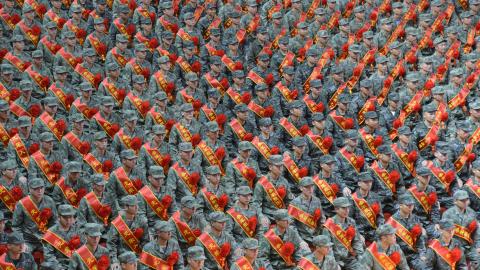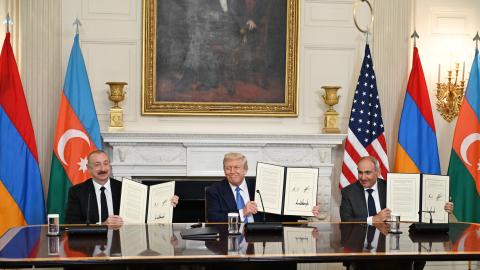Last week at an army base in Fort Hood, Texas, Major Nidal Malik Hasan killed 13 people—12 soldiers and one civilian—and wounded 42. The 39-year-old army psychiatrist and son of Palestinian immigrants, who expressed his displeasure with the wars in Iraq and Afghanistan and called them wars against Islam, reportedly shouted “Allahu Akbar” before opening fire. With reports now surfacing that Hasan had tried to reach out to Al Qaeda, the argument here in the US concerns whether Hasan’s rampage was an act of Islamist terror or just the evil work of a man who lost his mind.
Most media coverage, at least initially, projected an opinion that focused on the latter. A series of articles in the New York Times contended that even though Major Hasan had not yet been deployed to Iraq or Afghanistan, his treatment of soldiers with Post-Traumatic Stress Disorder left him vulnerable to PTSD by proxy.
Regarding the Muslim angle, the mainstream press tried to have it both ways. On one hand, the press carefully avoided drawing any connections between Hasan’s violent actions and his faith. On the other, it gave credence to the claim that Hasan had suffered anti-Muslim harassment, despite an announcement made by a Muslim veteran affairs organization stating that no Muslim soldiers filed any reports of harassment. Nonetheless, Army Chief of Staff General George Casey Jr. feared that Hasan’s murderous rampage could “cause a backlash against some of our Muslim soldiers.”
And so, while the US media had adopted a theme that could have come straight out of Al-Quds Al-Arabi when it posited that “humiliation” and “grievance” is what turns decent folk into cold-blooded killers, General Casey, with twelve of his troops murdered, articulated the Islamist view of the world that portrays Muslims as a whole besieged by American aggressors. And yet despite the internalization of regional narratives, the atmosphere surrounding the episode was distinctly American, not only in the US Army’s politically-correct posture that overlooked the explicitly Islamist rhetoric in Hasan’s rants, but even in the backlash against the media.
Critics of the mainstream press charged it with whitewashing the nature and inspiration of the attack. In this view, Hasan was the agent of an ideology variously called radical Islam, Islamic extremism, Islamofascism, etc. that also motivates Middle Eastern actors like the Iranian regime, Hezbollah, Hamas and Al Qaeda. Therefore, in the American logic of things, the individuals and institutions that embody this set of pathological ideas that lead to bloodshed are collectively waging a campaign of Islamist terror.
So was Hasan’s spree an act of Islamist terror or not? Well, maybe that’s not the right question. As bad as it is to rationalize Hasan’s murders with psychological niceties, it is also mistaken to suggest that Islamist terror is merely the function of an ideological continuum. The fact is that both sides in the American debate are tangled in a web of symptoms – whether it is contact PTSD or Islamofascism. Both sides will do almost anything to pretend that the wars waged against the US are the accident of a way of thought, and not the concerted efforts of states—the issue where the important questions are.
Because the predominant American view holds that Islamist terror is largely the prerogative of non-state actors (remember how the Bush administration paid for the axis of evil speech and asserting that Saddam was involved in terror), Americans right and left have typically confused the war that would defeat state sponsors of terror with the police work that captures or kills individual terrorists. For example, while the American right derided John Kerry in 2004 and Barack Obama in 2008 for wanting to treat terror as a police matter rather than a war, one of the right’s heroes, General David Petraeus, has been lauded for implementing a counterinsurgency strategy in Iraq that is essentially a policy of heavy and aggressive policing.
Not only has the American military failed to go after the Iraq war’s center of gravity – i.e., those states without which the various insurgencies could not arm themselves – but it has even sent delegations to Damascus to see if after six years of proxy warfare against the US the Syrians are now willing to make an American exit from Iraq easier. Moreover, one of the reasons that Washington, first Bush and now Obama, has been reluctant to use force to bring down the Iranian nuclear program is for fear that the Iranians will retaliate in Iraq. In other words, the US has not won the war in Iraq because it has not routed the one party that American policymakers and officers think capable of ruining the peace in Iraq.
Rather than campaign against the rulers, regimes and intelligence services that are fighting against them, the Americans call war the pursuit of “insurgents” and other non-state actors, who resemble Nidal Malik Hasan in everything but nationality. Because the Americans have confused war with policing, they are incompetent at both policing, which is why they did not apprehend Hasan before he opened fire, and war, which is why they have not yet won in Iraq, and why they continue to debate the merits of fighting in Afghanistan, where there can be no coherent US strategy since there are no strategic interests at stake and the only reason to be there is to shoot at an unending and irrelevant string of Major Hasans.
Thus, the point is not so much that the Americans have failed to define their enemy properly and have thus wasted lives, money, time and prestige by fighting against an idea – Islamic extremism, radical Islam, Islamofascism, etc. – but that they have failed to understand the basic definition of war and are consequently incapable of distinguishing between friends and enemies and deadly nuisances, both foreign and, in the case of Hasan, domestic. And this is why no one identified Hasan as a problem before he struck, why some now seek to exculpate him and why others confuse him with the deeper and abiding problem, which, I repeat at the risk of redundancy, is the states that support terror.
And so the real question is what can the story of non-state actor Major Hasan teach us about the role of states in terror?
Let us imagine that Hasan was a field-grade officer not in the US Army, but in an Arab military, and that the domestic intelligence service that had discovered his communications with a radical cleric was not the FBI, but an Arab mukhabarat. Arab intelligence officers would either torture and kill him, or torture him and use him to penetrate an Islamist group to their own benefit, perhaps by subverting a regional rival, or the Americans. It is darkly comical to imagine the Americans turning Major Hasan against, say, the Syrian regime, as Damascus has directed its own Islamist problem against the Iraqis and Americans in Iraq, and the Lebanese, suggesting that in the Middle East, “non-state” actors are those whose actions are either shaped by the state or constrained by it. And so the genuine danger is not the pathology of someone like Mr. Hasan, but rather its manipulation by people who really know what they’re doing. And that is a problem that belongs not only to the Americans.

















